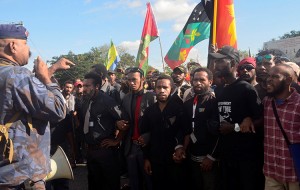Problems in Papua New Guinea
June 10, 2016

Police confront protesters in Port Moresby, Papua New Guinea, on June 8, 2016.
Credit: © PNGFM News/Reuters
On Wednesday, June 8, weeks of simmering protests in the South Pacific nation of Papua New Guinea (PNG) boiled over, leading to clashes between students and police. At the University of Papua New Guinea (UPNG) in Port Moresby, the capital, about 1,000 student protesters—who are calling for the resignation of Prime Minister Peter O’Neill over corruption charges—tried to march to Parliament House where they hoped to present a petition for O’Neill’s removal. Police barred their path, however, and—in a confusing confrontation—police opened fire on the students. Frightened students fled the gunfire, but not before several people were injured. PNG officials claim that several people were hurt, but that no one was killed. Opposition groups—and the students themselves—say that four people were killed and many more injured. Details remain unclear.
Regardless of the truth, the violence—as so often happens—spurred further violence. Angry UPNG students set fire to dormitories, blocked streets, and—according to police—even tried to burn down a police barracks. The unrest spread to the highland cities of Goroka and Mount Hagen, as well as Lae, PNG’s second-largest city. The nation’s top court ordered a halt to the protests, as well as an end to a long-running UPNG boycott of classes. The situation has quieted somewhat in recent days, but the undercurrent of anger and dissatisfaction remains combustible and close to the surface.
Prime Minister O’Neill has been accused of fraud and has dodged an arrest warrant on corruption charges since 2014. O’Neill has fired numerous public officials and government ministers who have opposed him, as well as the nation’s police commissioner and attorney general. He claims the charges against him are politically motivated and absolutely refuses to step down. Papua New Guinea has suffered from corruption and widespread poverty for many years.


